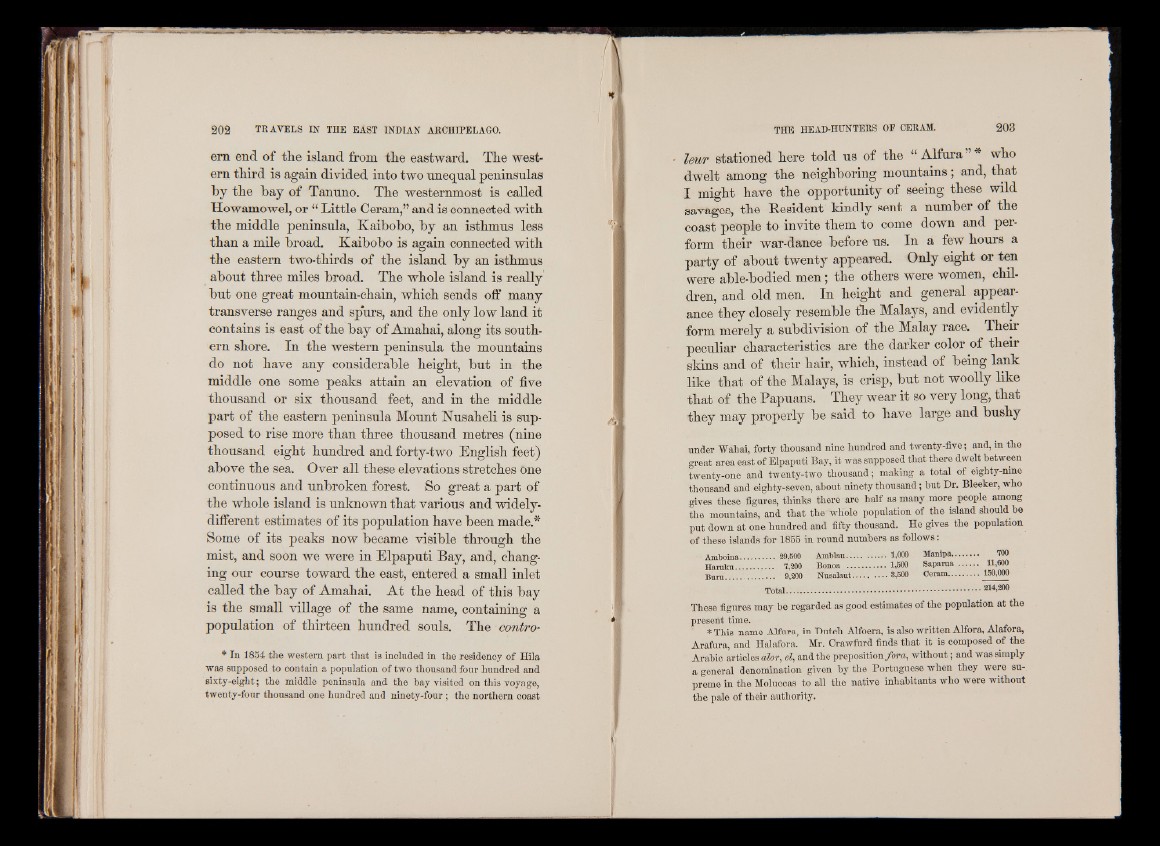
ern end of the island from the eastward. The western
third is again divided into two unequal peninsulas
by the bay of Tanuno. The westernmost is called
Howamowel, or “ Little Ceram,” and is connected with
the middle peninsula, Kaibobo, by an isthmus less
than a mile broad. Kaibobo is again connected with
the eastern two-thirds of the island by an isthmus
about three miles broad. The whole island is really
but one great mountain-chain, which sends off many
transverse ranges and spurs, and the only low land it
contains is east of the bay of Amahai, along its southern
shore. In the western peninsula the mountains
do not have any considerable height, but in the
middle one some peaks attain an elevation of five
thousand or six thousand feet, and in the middle
part of the eastern peninsula Mount Nusaheli is supposed
to rise more than three thousand metres (nine
thousand eight hundred and forty-two English feet)
above the sea. Over all these elevations stretches One
continuous and unbroken forest. So great a part of
the whole island is unknown that various and widely-
different estimates of its population have been made.*
Some of its peaks now became visible through the
mist, and soon we were in Elpaputi Bay, and, changing
our course toward the east, entered a small inlet
called the bay of Amahai. At the head of this bay
is the small village of the same name, containing a
population of thirteen hundred souls. The contro-
* In 1854 the western part that is included in the residency of Hila
was supposed to contain a population of two thousand four hundred and
sixty-eight; the middle peninsula and the hay visited on this voyage,
twenty-four thousand one hundred and ninety-four ; the northern coast
lew stationed here told us of the “ A lfura” * who
dwelt among the neighboring mountains; and, that
I might have the opportunity of seeing these wild
savages, the Resident kindly sent a number of the
coast people to invite them to come down and perform
their war-dance before us. In a few hours a
party of about twenty appeared. Only eight or ten
were able-bodied men; the others were women, children,
and old men. In height and general appearance
they closely resemble fhe Malays, and evidently
form merely a subdivision of the Malay race. Their
peculiar characteristics are the darker color of their
skin a and of their hair, which, instead of being lank
like that of the Malays, is crisp, but not woolly like
that of the Papuans. They wear it so very long, that
they may properly be said to have large and bushy
under Wahai, forty thousand nine hundred and twenty-five; and, in the
great area east of Elpaputi Bay, it was supposed that there dwelt between
twenty-one and twenty-two thousand; making a total of eighty-nine
thousand and eighty-seven, about ninety thousand; but Dr. Bleeker, who
gives these figures, thinks there are half as many more people among
the mountains, and that the whole population of the island should be
put down at one hundred and fifty thousand. He gives the population
of these islands for 1855 in round numbers as follows:
Am b oin a ................... 29,500 A ra b ia n ...................... 1,000 M a nip a ............. 700
n .m h , 7,200 Bonoa ....................... 1,500 Saparna 11,600
B u rn 9,200 N u s a la u t................... 3,500 Ceram................ 150,000
T o ta l...................................................................................................214,200
These figures may be regarded as good estimates of the population at the
present time.
*This name Alfura, in Dutch Alfoera, is also written Alfora, Alafora,
Arafura, and Halafora. Mr. Orawfurd finds that it is composed of the
Arabic articles alov, el, and the preposition foTd, without; and was simply
a general denomination given by the Portuguese when they were supreme
in the Moluccas to all the native inhabitants who were without
the pale of their authority.